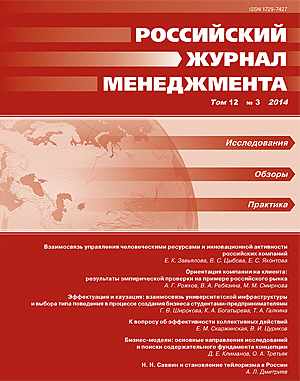Взаимосвязь управления человеческими ресурсами и инновационной активности российских компаний
Аннотация
В условиях современной экономики инновационная активность компаний становится важным источником их конкурентоспособности, а поиск инструментов стимулирования инноваций приобретает особую актуальность. В литературе представлены факты, свидетельствующие о том, что инновационная направленность стратегии и практики управления персоналом влияет на инновационную активность компаний. В настоящей статье проанализирован опыт отечественных и зарубежных компаний, проведено эмпирическое исследование взаимосвязи стратегии и практик управления персоналом, инновационного рабочего поведения и инновационной активности российских компаний.
Ключевые слова:
инновационная активность, инновационное рабочее поведение, управление человеческими ресурсами
Скачивания
Библиографические ссылки
The List of References in Cyrillic Transliterated into Latin Alphabet
Загрузки
Опубликован
Как цитировать
Выпуск
Раздел
Лицензия
Статьи журнала «Российский журнал менеджмента» находятся в открытом доступе и распространяются в соответствии с условиями Лицензионного Договора с Санкт-Петербургским государственным университетом, который бесплатно предоставляет авторам неограниченное распространение и самостоятельное архивирование.





